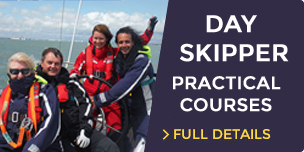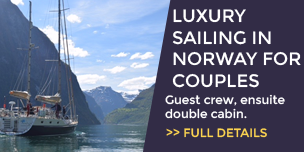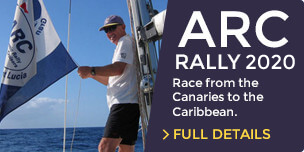ARC 2019 – Day 11 – “Whoa we’re halfway there” (nearly)
1,436 views | December 4th, 2019Halfway to paradise
Today is day 10 of the ARC, we have close to 1,600 nautical miles of Atlantic Ocean behind us and we just encountered our first real squall. At this time last year I had never even heard of the ARC. This past April, while visiting St Lucia with Molly, we happened into Spinnakers, a charming seafood restaurant right on the beach in Rodney Bay. The most memorable part of the evening, aside from the woman sitting across the table from me, was the spectacular nautical photos hanging on the walls. They all depicted sleek racing sailboats hammering through massive seas and pounded by wind and rain.
To a man, the crew was kitted out in waterproof foul weather gear, clipped in, and hanging on for dear life, but mostly sporting ear to ear grins. I asked the bartender where the photos were taken and he told me about the ARC, a 3,000 nautical mile race across the Atlantic Ocean. I asked why the photos were on display in his restaurant and he explained that this was the finish line for the ARC. My next question was obvious, how do I get into this race. Seven months later I found myself packing to head over to the Canary Islands to join a 14 man crew setting out on the ARC.
Making good time
Today I found myself at the helm of the Challenger when the hairs on the back of my neck perked up when I first felt the cool wet wind make contact. California, my home for the past 20 years, has lots of predictable Pacific storms but is not known for surprise squalls. However, years of sailing on Long Island Sound had taught me the unmistakable signs of an impending front moving through. Scanning the horizon I could see a sizeable squall a few miles behind me and rapidly approaching. I already had on my life jacket but was otherwise dressed in shorts and a tee shirt. I clipped on while everyone else ran below deck to grab their foul weather gear while I manned the helm. The first mate asked if I would like to run down and grab my waterproofs. I told her no, as I did not want to give up the helm just to stay a bit drier.
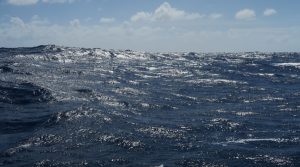
The Open Ocean
Practising for years with Eric, Mark, and George, my partners on the Sunbum, in every Pacific Storm Mother Nature could throw our way, had me well prepared for what came next. The wind speed nearly doubled and the rain started to douse us. With a stronger driving wind, I had more boat speed and more control at the helm through the large confused swells as long as I kept my whit’s about me and prevented the boat from rounding up or gybing.
At its peak, the Challenger hit 14.0 kts, my new personal record on a mono-hull and apparently tied with Mike for the highest boat speed thus far on our journey. The squall passed nearly as quickly as it approached and I finally relinquished the helm and ran below deck for some dry clothes. Most land lovers would consider this experience a nightmare but for me it was truly a sailors wet dream. Riding out the squall at the helm brought back vivid memories of the photos at Spinnakers, and made me wish a drone with a GoPro camera had been flying overhead to capture the enormity of the situation and the expressions on our faces to add to the collection. A big thanks to Molly for helping me discover the ARC, and a bigger shout to her for allowing me to participate in it.
Love and kisses to all
Gary
Hi All.
Well, we’re finally rocketing along in the tradewinds heading directly west towards St Lucia, after a somewhat frustrating time at low speed heading south to reach these fabled winds. We’re deep into the journey now and the experience is quite well described encapsulated by a description of my last watch, so here goes…
The watch was a split one, from 7pm to 11pm yesterday and then again from 3am to 7am this morning. During this time we helm the boat and make any necessary sail changes. Prior to starting we had dinner in the galley in Challenger 2’s interior, where we quietly contemplated the task to come, made aware through the pitching and rolling of the boat and the whooshing sound of water on the hull, of the big seas, strong winds and the responsibility towards the rest of the crew to keep the boat straight as she surfs down the waves.
Using every space available
There is no space wasted inside Challenger 2. Under most floor panels food and other consumables are stockpiled and nets are hung in the galley above the table, in which were stored fruit and vegetables but we’ve munched our way through most of the tastier items. There are a range of odours; primarily food, people and diesel oil – the latter primarily because we have a stand-alone generator which charges our batteries and provides power for the water-maker.
It’s therefore a huge contrast to climb the ladder to the deck, from the warmth and light, through the letterbox sized hatch, to the other reality – the exterior. Looking aft you immediately see, illuminated by bright moonlight, the huge swells rolling from the horizon towards the boat, Above the horizon a brilliant starscape, with Orion rising.
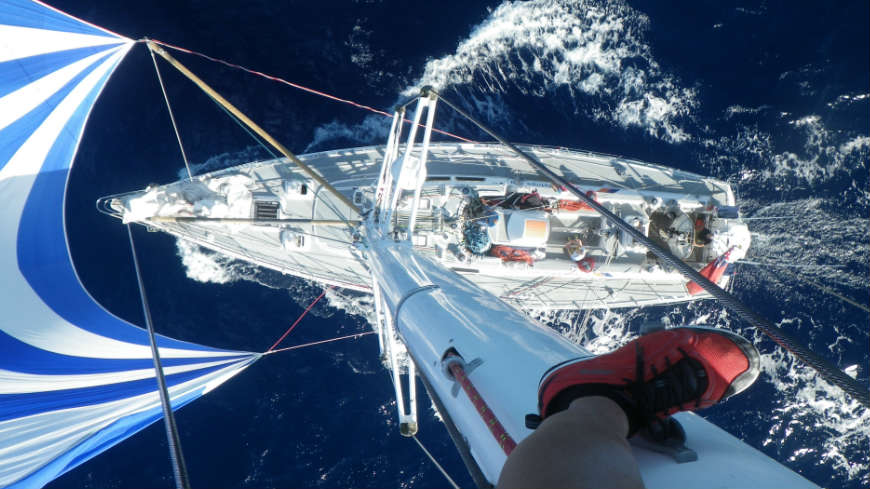
Ahoy down there!
The watch leader takes the helm and begins the cycle – twenty minutes each. The waves rear-up from behind as they outpace the boat, hastening from Africa to South America and as each one catches us in turn, it lifts Challenger’s stern, which starts to slide off to one or other side. Our job is to maintain the desired course and, importantly, control of the boat. It’s essential to avoid her being pushed sideways to the waves, where she would be vulnerable to each following wave in turn, and with no speed to easily manoeuvre out of the situation. So it’s twenty minutes of intense concentration and physical effort, sometimes throwing the wheel and others gently correcting as we anticipate the effect of each wave and surf down the face of each swell, grinning maniacally. The speed seems intense and far higher than in daylight.
After a few goes, it’s off watch for three hours sleep, followed by another round from 3am to 7am. Only this time the moon has set, it’s very dark and the other watch have gybed the boat so the sails are on the other side, which is quite disorientating when you’ve just woken up. When not wrestling with the helm, you spend your time staring at the sea or gazing at the sky, waiting for the frequent spectacular meteorites that streak across the sky, before sometimes a final flash.
We all stare at the light patch in the east, hoping the sun will hurry-up and show it’s face. Finally it does and we wake our colleagues, have a rushed breakfast and retire sweaty to our bunks for a few hours well-earned sleep.
Love to all. Take care.
Jim
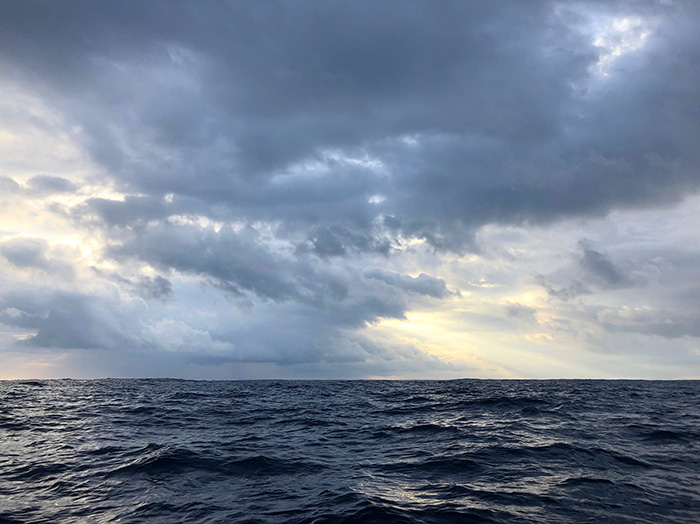
Atlantic Squall
Skippers Log
Date : Wednesday 4 December 2019
Time : 12:00 GMT (10am Boat Time)
Position : 19.59 N 37.57 W
Position : Halfway between Africa and South America
Destination : Rodney Bay, St Lucia
ETA : 0550 Dec 10 (GPS)
DTF : 1376 Distance Run 1554
24 Hour Run : 207 DMG in 24 Hours : 195
Required Knots for 15 Dec : 5.2, Arrival at 8 Knots : 11 Dec
Wind : AWA : 140 AWS : 12
Gybe Angles (M) 244 264 304
Sailplan : Full Main, Yankee 1, Staysail
POB : 14, all in good health and happy
Today on Challenger 2 :
Breakfast : Cereal and Fruit Salad Lunch : Spanish Omelets Dinner : Sausages & Mash
Music : Some Robbie, and other tunes…
Fishing Score : 27/11 1x Large Dorado – Fishing suspended
Notes and comments:
A midnight gybe has put us on a Southerly course for a change, and now at least visually heading in the right direction on the chart. We should be on this gybe for a few days so those who were rolling out of bed naked onto those sleeping on the bunk below will hopefully stop doing so. First squall of the race this morning. Rain but rather than nice gusts of wind to play in, it all just died and the boat flopped for a while, crashing the main against the rig.
Genny still purring along well.
Food working well, still some fresh fruit – mainly apples and oranges now, and the bananas are still mostly green and I’m not sure will ripen before they go rotten. Veg is all still in good condition, the fresh stuff which was looking tired has been sliced/diced and frozen. Cheese is in short supply. I bought a large supply, they just seem to have attacked it with vigor. Some Laughing Cow left. Lots of Milk and Tins.
Some sights still being taken, but I don’t see a lot of use of the reduction tables yet. I have run through a few examples with those interested.
Halfway fancy dress party tomorrow !
Ricky, Skipper
Posted by: First Class Sailing

